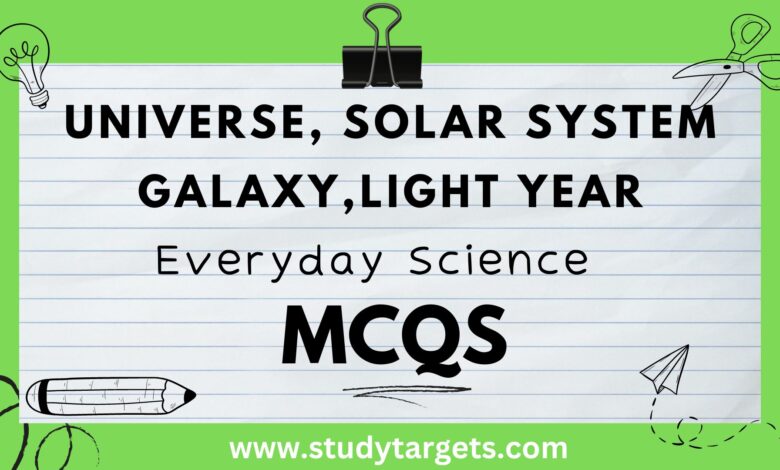Everyday Science MCQs

Our Universe:
1. What is the estimated age of the universe?
a) 4.6 billion years
b) 13.7 billion years
c) 10 million years
d) 100 billion years
Answer: b) 13.7 billion years
2. The expansion of the universe was first observed by whom?
a) Albert Einstein
b) Edwin Hubble
c) Nicolaus Copernicus
d) Galileo Galilei
Answer: b) Edwin Hubble
3. The “Big Bang” theory proposes that the universe originated from:
a) A massive explosion
b) A collision of galaxies
c) The collapse of a supermassive star
d) The collision of black holes
Answer: a) A massive explosion
4. What is the name given to the leftover radiation from the Big Bang, which fills the entire universe?
a) Cosmic rays
b) Gamma rays
c) Cosmic microwave background radiation
d) X-rays
Answer: c) Cosmic microwave background radiation
5. The vast collections of galaxies, stars, and other celestial objects are grouped together in large structures known as:
a) Nebulas
b) Black holes
c) Constellations
d) Clusters and superclusters
Answer: d) Clusters and superclusters
6. What is the name of the theory that describes the merging of general relativity and quantum mechanics?
a) Theory of Everything
b) Unified Field Theory
c) Quantum Gravity
d) Grand Unified Theory
Answer: c) Quantum Gravity
7. Approximately what percentage of the universe is composed of dark matter, a mysterious form of matter that does not emit light or energy?
a) 5%
b) 27%
c) 68%
d) 95%
Answer: b) 27%
8. The universe’s expansion is accelerating due to the influence of a mysterious force called:
a) Gravity
b) Dark energy
c) Dark matter
d) Anti-gravity
Answer: b) Dark energy
9. What is the name of the galaxy that is considered to be the closest large galaxy to our Milky Way?
a) Andromeda Galaxy
b) Triangulum Galaxy
c) Pinwheel Galaxy
d) Sombrero Galaxy
Answer: a) Andromeda Galaxy
10. What is the name of the space telescope launched by NASA that has provided valuable insights into the universe’s history and expansion?
a) Kepler Space Telescope
b) Hubble Space Telescope
c) Chandra X-ray Observatory
d) James Webb Space Telescope
Answer: b) Hubble Space Telescope
11. The “Big Bang” theory proposes that the universe originated from:
a) A massive explosion
b) A collision of galaxies
c) The collapse of a supermassive star
d) The collision of black holes
Answer: a) A massive explosion
12. What is the name given to the leftover radiation from the Big Bang, which fills the entire universe?
a) Cosmic rays
b) Gamma rays
c) Cosmic microwave background radiation
d) X-rays
Answer: c) Cosmic microwave background radiation
13. The vast collections of galaxies, stars, and other celestial objects are grouped together in large structures known as:
a) Nebulas
b) Black holes
c) Constellations
d) Clusters and superclusters
Answer: d) Clusters and superclusters
14. What is the name of the theory that describes the merging of general relativity and quantum mechanics?
a) Theory of Everything
b) Unified Field Theory
c) Quantum Gravity
d) Grand Unified Theory
Answer: c) Quantum Gravity
15. Approximately what percentage of the universe is composed of dark matter, a mysterious form of matter that does not emit light or energy?
a) 5%
b) 27%
c) 68%
d) 95%
Answer: b) 27%
16. The universe’s expansion is accelerating due to the influence of a mysterious force called:
a) Gravity
b) Dark energy
c) Dark matter
d) Anti-gravity
Answer: b) Dark energy
17. What is the name of the galaxy that is considered to be the closest large galaxy to our Milky Way?
a) Andromeda Galaxy
b) Triangulum Galaxy
c) Pinwheel Galaxy
d) Sombrero Galaxy
Answer: a) Andromeda Galaxy
18. What is the name of the space telescope launched by NASA that has provided valuable insights into the universe’s history and expansion?
a) Kepler Space Telescope
b) Hubble Space Telescope
c) Chandra X-ray Observatory
d) James Webb Space Telescope
Answer: b) Hubble Space Telescope
Sun & Our Solar System:
1. What is the primary source of energy for our solar system?
a) Moon
b) Earth
c) Sun
d) Mars
Answer: c) Sun
2. The Sun is classified as what type of star?
a) Red dwarf
b) White dwarf
c) Yellow dwarf
d) Blue giant
Answer: c) Yellow dwarf
3. What is the approximate age of the Sun?
a) 2 billion years
b) 4.6 billion years
c) 10 billion years
d) 13.7 billion years
Answer: b) 4.6 billion years
4. The Sun’s energy is primarily generated through:
a) Nuclear fusion
b) Nuclear fission
c) Radioactive decay
d) Gravitational collapse
Answer: a) Nuclear fusion
5. The outermost layer of the Sun’s atmosphere is called the:
a) Photosphere
b) Chromosphere
c) Corona
d) Core
Answer: c) Corona
6. What is the temperature of the Sun’s core, where nuclear fusion occurs?
a) 5,500 degrees Celsius
b) 15,000 degrees Celsius
c) 1 million degrees Celsius
d) 15 million degrees Celsius
Answer: d) 15 million degrees Celsius
7. The process of converting hydrogen into helium in the Sun’s core is known as:
a) Nuclear fission
b) Nuclear fusion
c) Nuclear decay
d) Nuclear reaction
Answer: b) Nuclear fusion
8. What is the average distance of the Earth from the Sun, also known as an astronomical unit (AU)?
a) 100,000 km
b) 149,600,000 km
c) 1,000,000 km
d) 93,000,000 miles
Answer: b) 149,600,000 km
9. What is the Sun’s approximate surface temperature?
a) 5,500 degrees Celsius
b) 15,000 degrees Celsius
c) 1 million degrees Celsius
d) 15 million degrees Celsius
Answer: a) 5,500 degrees Celsius
10. The visible surface of the Sun, where most of the light is emitted, is called the:
a) Photosphere
b) Chromosphere
c) Corona
d) Convection zone
Answer: a) Photosphere
11. The Sun’s magnetic activity causes dark, cooler regions on its surface known as:
a) Solar flares
b) Sunspots
c) Solar prominences
d) Solar wind
Answer: b) Sunspots
12. The total solar eclipse occurs when the Moon:
a) Passes between the Earth and the Sun, blocking the Sun’s light
b) Passes between the Sun and the Earth, blocking the Sun’s light
c) Is positioned to the right of the Sun, casting a shadow on Earth
d) Is positioned to the left of the Sun, casting a shadow on Earth
Answer: a) Passes between the Earth and the Sun, blocking the Sun’s light
13. What is the term for the continuous stream of charged particles released by the Sun into space?
a) Solar flares
b) Solar wind
c) Solar prominence
d) Solar corona
Answer: b) Solar wind
14. The layer of the Sun’s atmosphere directly above the photosphere is called the:
a) Corona
b) Chromosphere
c) Convection zone
d) Core
Answer: b) Chromosphere
15. The Sun’s energy is carried from the core to the surface through a process called:
a) Nuclear fission
b) Nuclear fusion
c) Conduction
d) Convection
Answer: d) Convection
16. What is the term for the massive explosions on the Sun’s surface that release a tremendous amount of energy?
a) Solar flares
b) Sunspots
c) Solar prominences
d) Solar wind
Answer: a) Solar flares
17. What is the approximate diameter of the Sun?
a) 100,000 km
b) 500,000 km
c) 1 million km
d) 1.4 million km
Answer: d) 1.4 million km
18. The Sun is located at the center of a rotating system of planets, asteroids, and comets known as the:
a) Solar System
b) Milky Way Galaxy
c) Andromeda Galaxy
d) Black Hole
Answer: a) Solar System
19. The Sun’s gravitational pull keeps the planets in their orbits. What is the force that opposes this gravitational pull and prevents planets from falling into the Sun?
a) Centripetal force
b) Frictional force
c) Inertial force
d) Centrifugal force
Answer: d) Centrifugal force
20. The Sun will eventually exhaust its nuclear fuel and undergo a transformation into a red giant. What will happen to Earth during this phase?
a) It will be consumed by the Sun.
b) It will be ejected into space.
c) It will move to a farther orbit.
d) It will be scorched but not engulfed.
Answer: a) It will be consumed by the Sun.
21. Which planet is closest to the Sun?
a) Venus
b) Earth
c) Mercury
d) Mars
Answer: c) Mercury
22. What is the largest planet in our solar system?
a) Venus
b) Jupiter
c) Saturn
d) Neptune
Answer: b) Jupiter
33. The Great Red Spot is a prominent feature found on which planet?
a) Earth
b) Mars
c) Jupiter
d) Saturn
Answer: c) Jupiter
34. Which planet is known as the “Red Planet” due to its reddish appearance?
a) Venus
b) Mercury
c) Mars
d) Saturn
Answer: c) Mars
35. Which planet has the most complex ring system in our solar system?
a) Venus
b) Mars
c) Jupiter
d) Saturn
Answer: d) Saturn
36. Which planet is referred to as the “Morning Star” or “Evening Star” due to its brightness?
a) Venus
b) Mars
c) Jupiter
d) Saturn
Answer: a) Venus
37. What is the largest moon in our solar system?
a) Luna (Moon)
b) Ganymede
c) Titan
d) Phobos
Answer: b) Ganymede
38. The four largest moons of Jupiter, known as the Galilean moons, are named after whom?
a) Famous astronomers
b) Greek deities
c) Roman emperors
d) Renowned explorers
Answer: b) Greek deities
39. Which planet has the strongest gravitational pull in our solar system?
a) Jupiter
b) Venus
c) Earth
d) Saturn
Answer: a) Jupiter
40. What is the hottest planet in our solar system?
a) Mercury
b) Venus
c) Mars
d) Jupiter
Answer: b) Venus
41. What is the smallest planet in our solar system?
a) Mercury
b) Mars
c) Earth
d) Pluto
Answer: a) Mercury
42. The Kuiper Belt is a region in our solar system that contains mainly:
a) Comets
b) Asteroids
c) Planets
d) Gas giants
Answer: a) Comets
43. Which planet is tilted the most, with an axial tilt of about 98 degrees?
a) Mars
b) Uranus
c) Neptune
d) Saturn
Answer: b) Uranus
44. The Oort Cloud is a hypothetical region in the outermost part of the solar system that is believed to be the source of:
a) Comets
b) Asteroids
c) Meteoroids
d) Solar flares
Answer: a) Comets
45. What is the largest volcano in our solar system, located on Mars?
a) Mount St. Helens
b) Olympus Mons
c) Mauna Kea
d) Mount Vesuvius
Answer: b) Olympus Mons
46. Which planet has the most extensive system of rings?
a) Jupiter
b) Saturn
c) Uranus
d) Neptune
Answer: b) Saturn
47. Which spacecraft was the first to land humans on the Moon?
a) Apollo 11
b) Voyager 1
c) Cassini-Huygens
d) Mars Rover Curiosity
Answer: a) Apollo 11
48. The asteroid belt is located between which two planets?
a) Earth and Mars
b) Jupiter and Saturn
c) Mars and Jupiter
d) Venus and Earth
Answer: c) Mars and Jupiter
49. Which planet experiences the “Great Dark Spot” and “Great White Spot” phenomena in its atmosphere?
a) Neptune
b) Uranus
c) Jupiter
d) Saturn
Answer: a) Neptune
50. Which planet is known for its prominent, beautiful ring system?
a) Venus
b) Earth
c) Saturn
d) Mars
Answer: c) Saturn
Our Galaxy:
1. What is the name of our galaxy?
a) Andromeda Galaxy
b) Milky Way Galaxy
c) Whirlpool Galaxy
d) Sombrero Galaxy
Answer: b) Milky Way Galaxy
2. The Milky Way is classified as what type of galaxy?
a) Elliptical galaxy
b) Spiral galaxy
c) Irregular galaxy
d) Lenticular galaxy
Answer: b) Spiral galaxy
3. The supermassive black hole at the center of the Milky Way is called:
a) Event Horizon
b) Dark Matter
c) Sagittarius A*
d) Cygnus X-1
Answer: c) Sagittarius A*
4. The Milky Way is estimated to be about how many light-years in diameter?
a) 100,000 light-years
b) 250,000 light-years
c) 50,000 light-years
d) 500,000 light-years
Answer: c) 50,000 light-years
5. Which component of the Milky Way is a dense, elongated region containing mostly old stars?
a) Galactic Nucleus
b) Galactic Halo
c) Galactic Bulge
d) Galactic Disk
Answer: c) Galactic Bulge
6. The region within the galactic disk where our solar system is located is called the:
a) Galactic Center
b) Galactic Nucleus
c) Orion Arm
d) Sagittarius Arm
Answer: c) Orion Arm
7. What is the name of the satellite galaxy that is gravitationally bound to the Milky Way?
a) Andromeda Galaxy
b) Large Magellanic Cloud
c) Triangulum Galaxy
d) Whirlpool Galaxy
Answer: b) Large Magellanic Cloud
8. The rotation of the Milky Way Galaxy causes it to have a distinctive shape known as:
a) The Galactic Bulge
b) The Galactic Core
c) The Galactic Halo
d) The Galactic Spiral Arms
Answer: d) The Galactic Spiral Arms
9. The astronomer who first correctly described the structure of the Milky Way as a disk with a central bulge was:
a) Galileo Galilei
b) Edwin Hubble
c) Nicolaus Copernicus
d) William Herschel
Answer: d) William Herschel
10. What is the name of the satellite launched by NASA to create a detailed 3D map of the Milky Way’s stars?
a) Kepler Space Telescope
b) Hubble Space Telescope
c) Gaia Space Observatory
d) Chandra X-ray Observatory
Answer: c) Gaia Space Observatory
11. The majority of the mass in the Milky Way is believed to be composed of:
a) Dark matter
b) Neutrinos
c) Black holes
d) White dwarfs
Answer: a) Dark matter
12. The Milky Way is part of a cluster of galaxies called the:
a) Virgo Cluster
b) Andromeda Cluster
c) Local Group
d) Coma Cluster
Answer: c) Local Group
13. The distance from one side of the Milky Way’s disk to the other is often measured in units called:
a) Light-years
b) Parsecs
c) Astronomical Units
d) Kilometers
Answer: b) Parsecs
14. What is the name of the nearest major galaxy to the Milky Way?
a) Andromeda Galaxy
b) Triangulum Galaxy
c) Whirlpool Galaxy
d) Pinwheel Galaxy
Answer: a) Andromeda Galaxy
15. The Milky Way is believed to have formed approximately how many years ago?
a) 4.5 billion years
b) 10 million years
c) 13.7 billion years
d) 100 billion years
Answer: c) 13.7 billion years
16. The outermost region of the Milky Way, containing the oldest stars and globular clusters, is known as the:
a) Galactic Center
b) Galactic Disk
c) Galactic Halo
d) Galactic Bulge
Answer: c) Galactic Halo
17. What is the name of the large-scale structure composed of the Galactic Center, the Galactic Bulge, and the Galactic Disk?
a) Galactic Core
b) Galactic Cluster
c) Galactic System
d) Galactic Spiral
Answer: c) Galactic System
18. The Milky Way is moving through space at an average velocity of approximately:
a) 100 kilometers per second
b) 200 kilometers per second
c) 300 kilometers per second
d) 400 kilometers per second
Answer: b) 200 kilometers per second
19. The Milky Way’s galactic disk is predominantly made up of:
a) Hydrogen gas
b) Helium gas
c) Oxygen gas
d) Nitrogen gas
Answer: a) Hydrogen gas
20. Which space mission provided substantial data that allowed scientists to map the Milky Way’s structure more accurately?
a) Mars Rover Mission
b) Hubble Space Telescope
c) Voyager Space Mission
d) Herschel Space Observatory
Answer: b) Hubble Space Telescope.
Light Year:
1. What is a light-year?
a) The time it takes light to travel in one year
b) The distance light travels in one year
c) The speed of light in one year
d) The brightness of light in one year
Answer: b) The distance light travels in one year
2. Approximately how many kilometers are there in one light-year?
a) 10,000 km
b) 100,000 km
c) 1 million km
d) 9.46 trillion km
Answer: d) 9.46 trillion km
3. The speed of light in a vacuum is approximately:
a) 30,000 kilometers per hour
b) 300,000 kilometers per hour
c) 300,000 kilometers per second
d) 300,000,000 kilometers per second
Answer: d) 300,000,000 kilometers per second
4. When we observe a star that is 10 light-years away, we see the star as it was:
a) 1 year ago
b) 5 years ago
c) 10 years ago
d) Instantly, as there is no time delay
Answer: c) 10 years ago
5. How do astronomers use light-years to measure distances in space?
a) By measuring the time it takes for light to travel between two points
b) By measuring the brightness of a star
c) By measuring the angle between two stars
d) By measuring the color of a star
Answer: a) By measuring the time it takes for light to travel between two points
6. The light from the Sun takes about how many minutes to reach Earth?
a) 1 minute
b) 8 minutes
c) 30 minutes
d) 1 hour
Answer: b) 8 minutes
7. What is the approximate distance to the nearest star to our solar system, Proxima Centauri, in light-years?
a) 1 light-year
b) 4 light-years
c) 40 light-years
d) 400 light-years
Answer: b) 4 light-years
8. Which of the following objects emits light that can take millions of light-years to reach us?
a) The Moon
b) The Sun
c) A nearby star
d) Distant galaxies
Answer: d) Distant galaxies
9. If a galaxy is located 100 million light-years away, how long does it take for the light from that galaxy to reach us?
a) 1 year
b) 10 years
c) 100 million years
d) 100 million seconds
Answer: c) 100 million years
10. What is the advantage of using light-years to measure astronomical distances?
a) It is easy to calculate and understand.
b) It allows for precise measurements of distance.
c) It takes into account the effects of gravity.
d) It is based on the brightness of stars.
Answer: b) It allows for precise measurements of distance.




